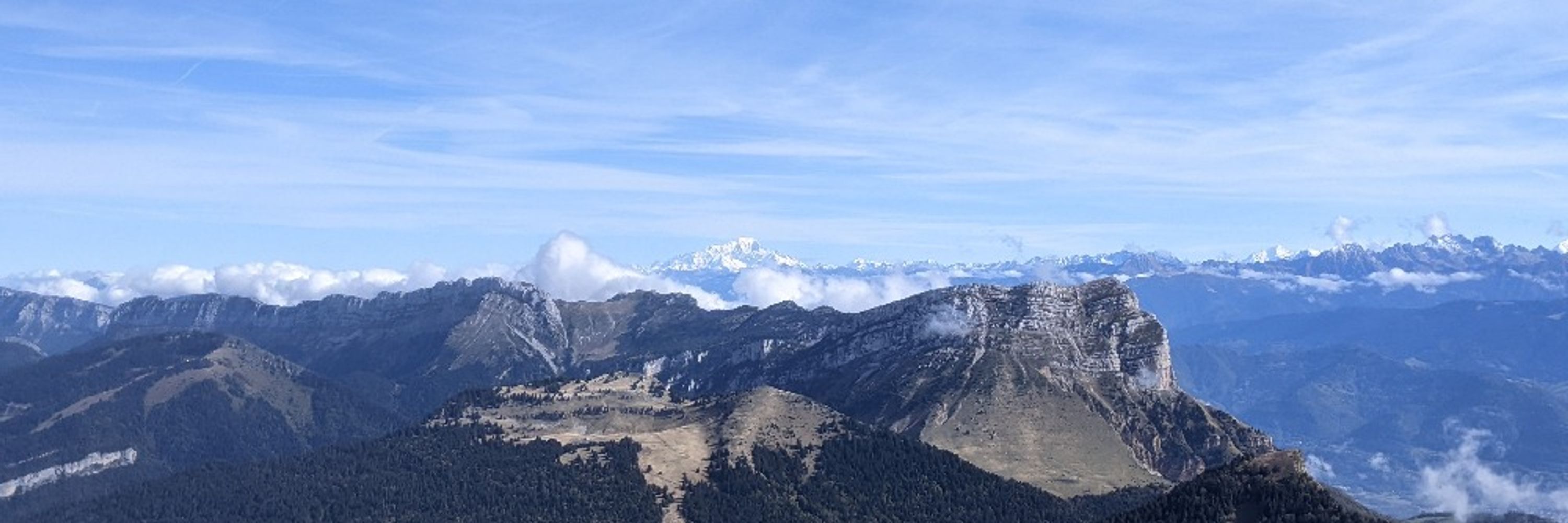
Jannes Münchmeyer
@jannesmunch.bsky.social
Postdoctoral researcher @gfz.bsky.social | Exploring earthquakes, tremors and slow slipping in the wild | he/him
Reposted by Jannes Münchmeyer
📈 Which seismic phase associator works best?
🧠Puente Huerta et al., benchmarked 5 algorithms testing their performance across diverse settings and under noisy-complex conditions
Read more: seismica.library.mcgill.ca/article/view...
------
@jannesmunch.bsky.social
🧠Puente Huerta et al., benchmarked 5 algorithms testing their performance across diverse settings and under noisy-complex conditions
Read more: seismica.library.mcgill.ca/article/view...
------
@jannesmunch.bsky.social

October 1, 2025 at 6:52 PM
📈 Which seismic phase associator works best?
🧠Puente Huerta et al., benchmarked 5 algorithms testing their performance across diverse settings and under noisy-complex conditions
Read more: seismica.library.mcgill.ca/article/view...
------
@jannesmunch.bsky.social
🧠Puente Huerta et al., benchmarked 5 algorithms testing their performance across diverse settings and under noisy-complex conditions
Read more: seismica.library.mcgill.ca/article/view...
------
@jannesmunch.bsky.social
Reposted by Jannes Münchmeyer
Our latest study in Nature, together with colleagues from @geomarkiel.bsky.social and universities from Greece, shows what happened beneath Santorini earlier this year when tens of thousands earthquakes shook the islands and the seafloor. It was magma. We also have 1/2
www.gfz.de/en/press/new...
www.gfz.de/en/press/new...

Magma displacement triggered tens of thousands of earthquakes
Magma displacement triggered tens of thousands of earthquakes: Analysis of the swarm of earthquakes around Santorini in early 2025 reveals causes and development of the seismic crisis
www.gfz.de
September 25, 2025 at 12:10 PM
Our latest study in Nature, together with colleagues from @geomarkiel.bsky.social and universities from Greece, shows what happened beneath Santorini earlier this year when tens of thousands earthquakes shook the islands and the seafloor. It was magma. We also have 1/2
www.gfz.de/en/press/new...
www.gfz.de/en/press/new...
This is one of the most interesting sequences I've worked on so far! It's great to see how machine learning can provide us with these detailed images of seismicity in near real time. I'm glad to have been able to contribute to this project.
New paper alert. Volcanic crisis reveals coupled magma system at Santorini and Kolumbo. Great work led by Marius and Jens, thanks all for working on that together! It can be found in today’s issue of Nature.
www.nature.com/articles/s41...
www.nature.com/articles/s41...

September 25, 2025 at 8:25 AM
This is one of the most interesting sequences I've worked on so far! It's great to see how machine learning can provide us with these detailed images of seismicity in near real time. I'm glad to have been able to contribute to this project.
Reposted by Jannes Münchmeyer
Introducing Xdas — a Python library designed to manipulate distributed acoustic sensing (DAS) data. #SRL ⚒️
pubs.geoscienceworld.org/ssa/srl/arti...
pubs.geoscienceworld.org/ssa/srl/arti...

September 10, 2025 at 2:01 AM
Introducing Xdas — a Python library designed to manipulate distributed acoustic sensing (DAS) data. #SRL ⚒️
pubs.geoscienceworld.org/ssa/srl/arti...
pubs.geoscienceworld.org/ssa/srl/arti...
SeisBench v.10 is out and it's time for some new models:
- SkyNet allows picking regional phases and can even distinguish Pn, Pg, Sn, Sg (beware of the Terminator though)
- SeisDAE brings easily retrainable seismic waveform denoising
Check out all changes here:
github.com/seisbench/se...
- SkyNet allows picking regional phases and can even distinguish Pn, Pg, Sn, Sg (beware of the Terminator though)
- SeisDAE brings easily retrainable seismic waveform denoising
Check out all changes here:
github.com/seisbench/se...

Release SeisBench v0.10 - SkyNet, SeisDAE and a more powerful model API · seisbench/seisbench
Major updates
The SkyNet model is now available in SeisBench. SkyNet is specifically designed to pick phase arrivals at regional distances (up to 20 degree) and also comes with a set of weights to...
github.com
August 11, 2025 at 10:19 AM
SeisBench v.10 is out and it's time for some new models:
- SkyNet allows picking regional phases and can even distinguish Pn, Pg, Sn, Sg (beware of the Terminator though)
- SeisDAE brings easily retrainable seismic waveform denoising
Check out all changes here:
github.com/seisbench/se...
- SkyNet allows picking regional phases and can even distinguish Pn, Pg, Sn, Sg (beware of the Terminator though)
- SeisDAE brings easily retrainable seismic waveform denoising
Check out all changes here:
github.com/seisbench/se...
SeisBench v0.9 is out now. Some highlights of the new version:
- The CWA dataset with broadband and strong motion data from Taiwan.
- The CEED dataset covering more than 4 million waveforms from California.
- A 20% speed-up when picking continuous datasets.
github.com/seisbench/se...
- The CWA dataset with broadband and strong motion data from Taiwan.
- The CEED dataset covering more than 4 million waveforms from California.
- A 20% speed-up when picking continuous datasets.
github.com/seisbench/se...
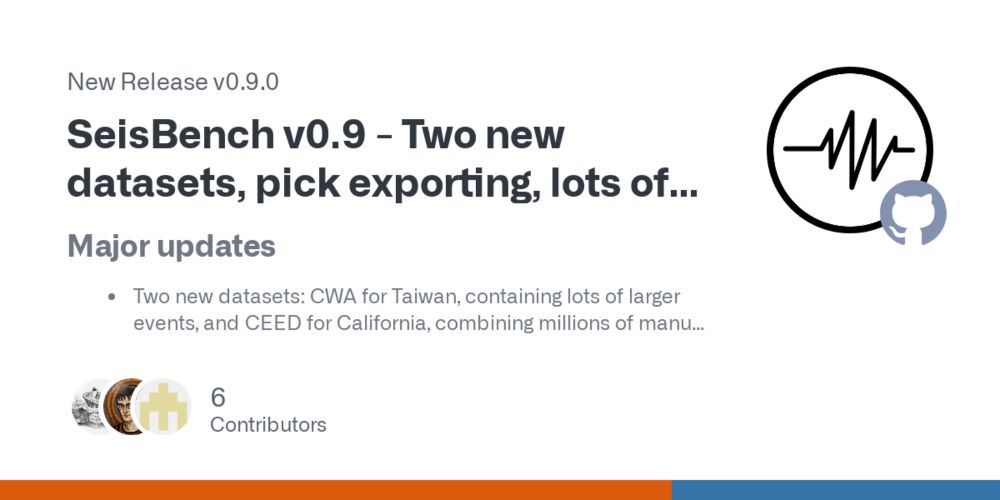
Release SeisBench v0.9 - Two new datasets, pick exporting, lots of small tweaks · seisbench/seisbench
Major updates
Two new datasets: CWA for Taiwan, containing lots of larger events, and CEED for California, combining millions of manual phase picks with rich metadata from Northern and Southern Ca...
github.com
May 14, 2025 at 12:03 PM
SeisBench v0.9 is out now. Some highlights of the new version:
- The CWA dataset with broadband and strong motion data from Taiwan.
- The CEED dataset covering more than 4 million waveforms from California.
- A 20% speed-up when picking continuous datasets.
github.com/seisbench/se...
- The CWA dataset with broadband and strong motion data from Taiwan.
- The CEED dataset covering more than 4 million waveforms from California.
- A 20% speed-up when picking continuous datasets.
github.com/seisbench/se...
Have you ever wondered how seismic swarms around slow slip events (SSEs) might work? In our recent work, we study the complex seismic migrations around the onset of a shallow SSEs in the Copiapó ridge in 2023. (1/2)
agupubs.onlinelibrary.wiley.com/doi/10.1029/...
agupubs.onlinelibrary.wiley.com/doi/10.1029/...

May 8, 2025 at 9:00 AM
Have you ever wondered how seismic swarms around slow slip events (SSEs) might work? In our recent work, we study the complex seismic migrations around the onset of a shallow SSEs in the Copiapó ridge in 2023. (1/2)
agupubs.onlinelibrary.wiley.com/doi/10.1029/...
agupubs.onlinelibrary.wiley.com/doi/10.1029/...
Looking forward to a week full of science and networking at #EGU25! Join my talk on Thursday afternoon if you want to learn about the seismicity in Northern Chile and how swarms reveal the mechanisms of slow slip.
#Train2EGU
#Train2EGU

April 27, 2025 at 12:27 PM
Looking forward to a week full of science and networking at #EGU25! Join my talk on Thursday afternoon if you want to learn about the seismicity in Northern Chile and how swarms reveal the mechanisms of slow slip.
#Train2EGU
#Train2EGU
The registration for our International Training School for AI in Seismology is open now! The school combines lectures, poster sessions, practical tutorials, and networking opportunities.
We're looking forward to welcoming you in Leipzig in May!
We're looking forward to welcoming you in Leipzig in May!

March 10, 2025 at 4:02 PM
The registration for our International Training School for AI in Seismology is open now! The school combines lectures, poster sessions, practical tutorials, and networking opportunities.
We're looking forward to welcoming you in Leipzig in May!
We're looking forward to welcoming you in Leipzig in May!
Our paper on QSeek is out in Seismica now. QSeek detects earthquakes and locates them precisely by backprojecting deep learning phase probability curves in time and space. And that at a blazingly fast speed! Thanks Marius Isken for this great work!
From Wave to Quake.
Isken et al., developed an AI-Driven Earthquake Detection and Localization methodologie.
Read now: 10.26443/seismica.v4i1.1283.
Isken et al., developed an AI-Driven Earthquake Detection and Localization methodologie.
Read now: 10.26443/seismica.v4i1.1283.
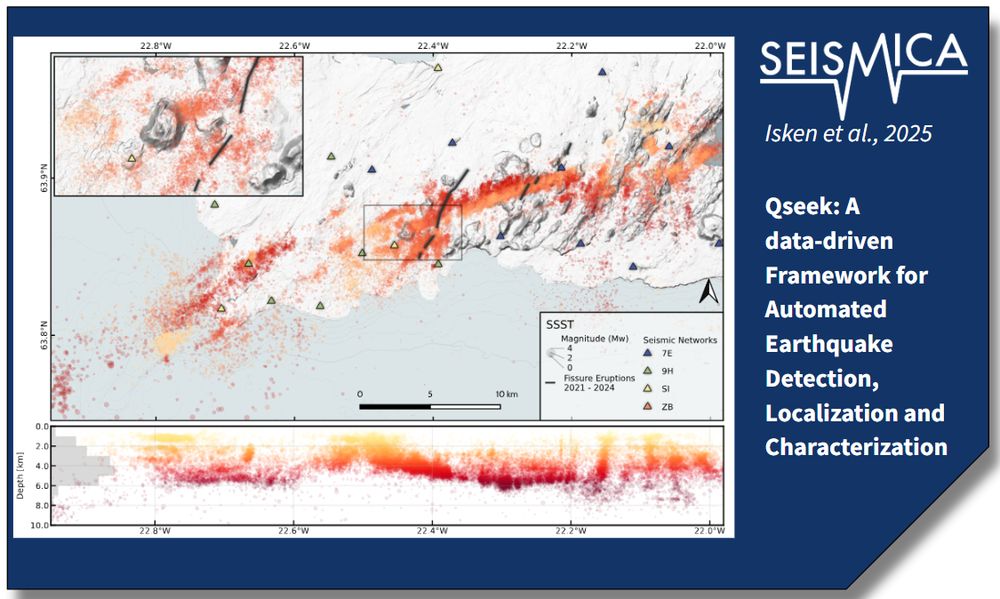
February 26, 2025 at 12:45 PM
Our paper on QSeek is out in Seismica now. QSeek detects earthquakes and locates them precisely by backprojecting deep learning phase probability curves in time and space. And that at a blazingly fast speed! Thanks Marius Isken for this great work!
Reposted by Jannes Münchmeyer
The main DEI page from @agu.org has been modified to take diversity out of the title. Glad to see it's not deleted entirely, but hey AGU, we're watching what you do and remembering the big game you once talked about supporting your diverse membership.
Today vs. January
Today vs. January


February 10, 2025 at 2:41 PM
The main DEI page from @agu.org has been modified to take diversity out of the title. Glad to see it's not deleted entirely, but hey AGU, we're watching what you do and remembering the big game you once talked about supporting your diverse membership.
Today vs. January
Today vs. January
Hi Seismo-Bluesky! I decided to test a pipeline with SeisBench, PyOcto, NonLinLoc, and HypoDD on the Santorini sequence. The level of activity (>4,500 events) is truly stunning! There are repeated bursts migrating backwards and forwards, spreading outwards from a narrow, almost linear channel.
February 10, 2025 at 1:23 PM
Hi Seismo-Bluesky! I decided to test a pipeline with SeisBench, PyOcto, NonLinLoc, and HypoDD on the Santorini sequence. The level of activity (>4,500 events) is truly stunning! There are repeated bursts migrating backwards and forwards, spreading outwards from a narrow, almost linear channel.
Reposted by Jannes Münchmeyer
🤖 Ready to use artificial intelligence to revolutionize seismology? Then join us at the International Training School "AI 4 Seismology" on May 5-8, 2025 at @scadsai.bsky.social in Leipzig.
So far confirmed trainers:
- Tarje Nissen-Meyer (@exeter.ac.uk )
- René Steinmann (@gfz.bsky.social )
So far confirmed trainers:
- Tarje Nissen-Meyer (@exeter.ac.uk )
- René Steinmann (@gfz.bsky.social )

February 9, 2025 at 3:53 PM
🤖 Ready to use artificial intelligence to revolutionize seismology? Then join us at the International Training School "AI 4 Seismology" on May 5-8, 2025 at @scadsai.bsky.social in Leipzig.
So far confirmed trainers:
- Tarje Nissen-Meyer (@exeter.ac.uk )
- René Steinmann (@gfz.bsky.social )
So far confirmed trainers:
- Tarje Nissen-Meyer (@exeter.ac.uk )
- René Steinmann (@gfz.bsky.social )
Reposted by Jannes Münchmeyer
OTD twenty years ago the 3rd strongest earthquake ever recorded by seismometers struck offshore the island of Sumatra. A tsunami followed killing more than 200,000 people. In the aftermath we helped develop a tsunami warning system for the region. Read more here: www.gfz-potsdam.de/en/press/new...

20 years after the tsunami disaster
20 years after the tsunami disaster
Thanks to the GITEWS (now InaTEWS) early warning system developed under the leadership of the GFZ from 2005 to 2008, it is not only the Indian Ocean that is better ...
www.gfz-potsdam.de
December 26, 2024 at 8:42 AM
OTD twenty years ago the 3rd strongest earthquake ever recorded by seismometers struck offshore the island of Sumatra. A tsunami followed killing more than 200,000 people. In the aftermath we helped develop a tsunami warning system for the region. Read more here: www.gfz-potsdam.de/en/press/new...
Reposted by Jannes Münchmeyer
I am so excited for everyone to see this amazing story about the mysterious seismic signal, mega-tsunami, giant rockslide, and perpetual wave machine of a fjord!
www.theguardian.com/environment/...
www.theguardian.com/environment/...
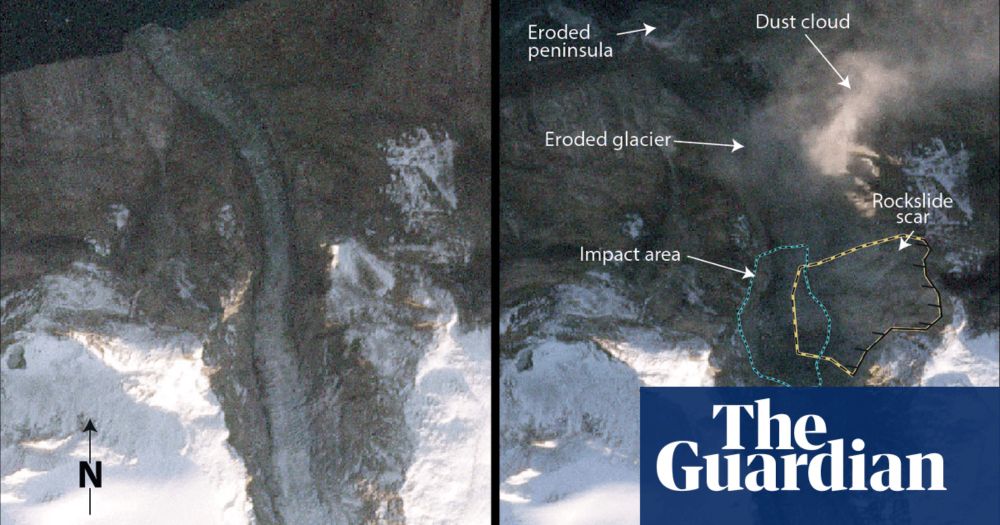
Entire Earth vibrated for nine days after climate-triggered mega-tsunami
Landslide in Greenland caused unprecedented seismic event that shows impact of global heating, say scientists
www.theguardian.com
September 12, 2024 at 6:07 PM
I am so excited for everyone to see this amazing story about the mysterious seismic signal, mega-tsunami, giant rockslide, and perpetual wave machine of a fjord!
www.theguardian.com/environment/...
www.theguardian.com/environment/...
SeisBench v0.8 is out now with three new datasets and a bunch of new augmentations! It's great to see so much input from the community!
Thanks to all contributors of this release!
github.com/seisbench/se...
Thanks to all contributors of this release!
github.com/seisbench/se...

Release SeisBench v0.8 - Volcanos, regional earthquakes, L'Aquila aftershocks and new augmentations · seisbench/seisbench
Major updates
SeisBench now features three new datasets, each covering an interesting new case:
VCSEIS contains seismic waveforms and annotations from diverse volcanos around the globe. In total, ...
github.com
August 26, 2024 at 1:27 PM
SeisBench v0.8 is out now with three new datasets and a bunch of new augmentations! It's great to see so much input from the community!
Thanks to all contributors of this release!
github.com/seisbench/se...
Thanks to all contributors of this release!
github.com/seisbench/se...
Reposted by Jannes Münchmeyer
Huge relief with the French election results! Really happy that I will not be living under a far-right government!
July 7, 2024 at 9:15 PM
Huge relief with the French election results! Really happy that I will not be living under a far-right government!
Reposted by Jannes Münchmeyer
Low-frequency earthquakes are essential markers for understanding slow fault deformation.
Can we automatically detect them?
@jannesmunch.bsky.social et al. can, using their novel deep-learning detector that does not require prior knowledge of the region:
seismica.library.mcgill.ca/article/view...
Can we automatically detect them?
@jannesmunch.bsky.social et al. can, using their novel deep-learning detector that does not require prior knowledge of the region:
seismica.library.mcgill.ca/article/view...

May 10, 2024 at 1:36 PM
Low-frequency earthquakes are essential markers for understanding slow fault deformation.
Can we automatically detect them?
@jannesmunch.bsky.social et al. can, using their novel deep-learning detector that does not require prior knowledge of the region:
seismica.library.mcgill.ca/article/view...
Can we automatically detect them?
@jannesmunch.bsky.social et al. can, using their novel deep-learning detector that does not require prior knowledge of the region:
seismica.library.mcgill.ca/article/view...
SeisBench v0.7 is out with low-frequency earthquake detection, a wider variety of OBS detection data and models, new data from Texas, and the ability to pick a day of waveforms in less than 1 second. Check it out on Github!
Thanks to all contributors of this large feature release!
Thanks to all contributors of this large feature release!
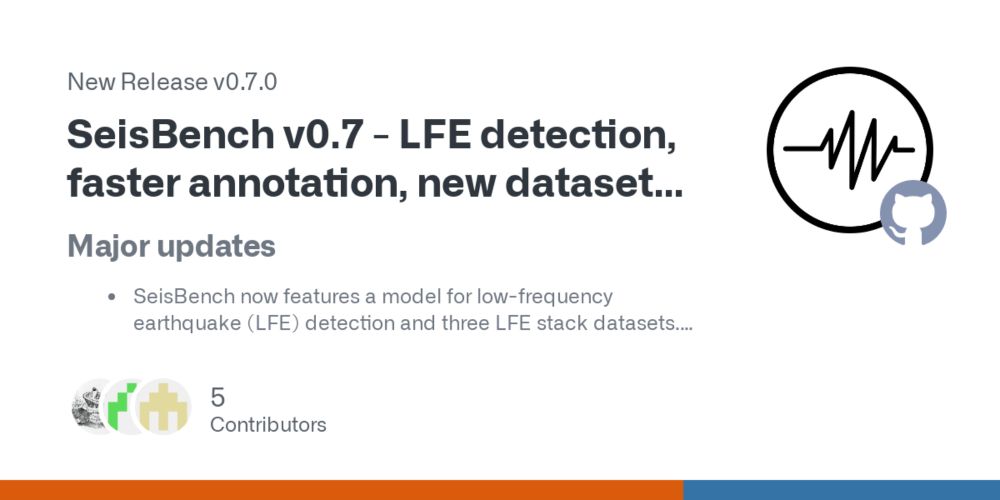
Release SeisBench v0.7 - LFE detection, faster annotation, new datasets and models, ... · seisbench/seisbench
Major updates
SeisBench now features a model for low-frequency earthquake (LFE) detection and three LFE stack datasets. The model can be plugged into regular earthquake detection workflows just as...
github.com
April 22, 2024 at 11:27 AM
SeisBench v0.7 is out with low-frequency earthquake detection, a wider variety of OBS detection data and models, new data from Texas, and the ability to pick a day of waveforms in less than 1 second. Check it out on Github!
Thanks to all contributors of this large feature release!
Thanks to all contributors of this large feature release!
Last week the SPIN ITN invited me to give a talk, so I spent have an hour talking about open source in science from a developer's perspective. Why do we need it? What are the challenges? How can I support open source?
You can watch the recording on YouTube.
You can watch the recording on YouTube.

Friday Seminar: SeisBench & PyOcto Lessons learned from building Open Source Software for seismology
Jannes Münchmeyer from ISTerre UGA presents his work on “SeisBench and PyOcto: Lessons learned from building open source software for seismology”This seminar...
www.youtube.com
March 30, 2024 at 1:12 PM
Last week the SPIN ITN invited me to give a talk, so I spent have an hour talking about open source in science from a developer's perspective. Why do we need it? What are the challenges? How can I support open source?
You can watch the recording on YouTube.
You can watch the recording on YouTube.
Happy to announce my first paper in Seismica! I present PyOcto, a novel phase association algorithm that can quickly identify earthquakes within large numbers of phase picks.
Check out PyOcto at github.com/yetinam/pyocto
Check out PyOcto at github.com/yetinam/pyocto
How can we quickly identify earthquakes from hundreds of thousands of phase picks?
Check Münchmeyer's (@jannesmunch.bsky.social) PyOcto: A high-throughput seismic phase associator.
See how it works and how it gets equal or better detection performance in shorter run times: doi.org/10.26443/sei...
Check Münchmeyer's (@jannesmunch.bsky.social) PyOcto: A high-throughput seismic phase associator.
See how it works and how it gets equal or better detection performance in shorter run times: doi.org/10.26443/sei...

January 30, 2024 at 2:48 PM
Happy to announce my first paper in Seismica! I present PyOcto, a novel phase association algorithm that can quickly identify earthquakes within large numbers of phase picks.
Check out PyOcto at github.com/yetinam/pyocto
Check out PyOcto at github.com/yetinam/pyocto
SeisBench v0.6 is out with the MLAAPDE dataset, a new async interface, and finally a backup repository. Thanks to all contributors! Looking forward to any contributions for v0.7. Just sumit a PR on Github!

Release SeisBench v0.6 - MLAAPDE, async interface, backup repository, ... · seisbench/seisbench
Major updates
The MLAAPDE dataset is now available through SeisBench. MLAAPDE is a large-scale dataset containing phase picks primarily at teleseismic distances. Big shoutout to Hank Cole at NEIC ...
github.com
January 9, 2024 at 3:57 PM
SeisBench v0.6 is out with the MLAAPDE dataset, a new async interface, and finally a backup repository. Thanks to all contributors! Looking forward to any contributions for v0.7. Just sumit a PR on Github!
After a great ML discussion last week at AGU, I'm looking forward to hosting the session on "Challenges and Opportunities of Machine learning in Solid Earth Geophysics" at EGU 2024 with Sophie Giffard-Roison, Fabio Corbi and Chris Marone.
Submit your abstract here:
Submit your abstract here:
Session SM2.3
meetingorganizer.copernicus.org
December 20, 2023 at 9:25 PM
After a great ML discussion last week at AGU, I'm looking forward to hosting the session on "Challenges and Opportunities of Machine learning in Solid Earth Geophysics" at EGU 2024 with Sophie Giffard-Roison, Fabio Corbi and Chris Marone.
Submit your abstract here:
Submit your abstract here:
Looking forward to a week of science at AGU. Wednesday morning I'll present my poster on LFE detection with deep learning. Wednesday afternoon I'll speak about the PyOcto phase associator.
And I already got the super cool @weareseismica.bsky.social tag!
And I already got the super cool @weareseismica.bsky.social tag!

December 12, 2023 at 12:36 AM
Looking forward to a week of science at AGU. Wednesday morning I'll present my poster on LFE detection with deep learning. Wednesday afternoon I'll speak about the PyOcto phase associator.
And I already got the super cool @weareseismica.bsky.social tag!
And I already got the super cool @weareseismica.bsky.social tag!


